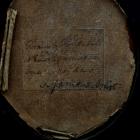inscribed on the reverse "Drawn by H Stubble/No5 lady Farrington/…..my Pair"
John Farrington, Capard House, Rosenallis, Co Laois, Ireland
Elizabeth Colden , daughter of Alexander Colden of New York City married Sir Anthony Farrington On 9 March 1766 at Trinity Church, New York, they had two sons and three daughters. Lady Farrington died, aged seventy-three, on 12 April 1824 at Wilton Cottage, Taunton, the home of her daughter, Mrs Cliffe.
Sir Anthony Farrington, first baronet (1742–1823), army officer, was born on 6 February 1742, the son of Charles Farrington (d. 1782) and his wife, Anne, daughter of Anthony Crouche. His father had entered the Royal Artillery as a matross in 1733 and died at Woolwich, as lieutenant-colonel commandant of the Royal Invalid Artillery, on 23 February 1782. Farrington entered the Royal Academy, Woolwich, on 3 March 1754 and was commissioned lieutenant fireworker on 29 October 1755. He went to Gibraltar in 1758 as a first lieutenant, returned to England in 1763 a captain-lieutenant, and, by the time he left to serve in America in 1764, he was a captain. Although he left for England in 1768, he returned to America in 1773 and remained there until May 1783. He served at Boston from 1774 to 1776, first seeing action at Bunker Hill, and was present subsequently at Brooklyn, Long Island, White Plains, Brandywine, and Philadelphia. He was promoted major in 1782 and lieutenant-colonel the same year.
Farrington commanded the artillery at Plymouth in 1788–9. In Gibraltar, where he commanded in 1790–91, Farrington battery is almost certainly named after him. Promoted colonel in 1791, he commanded Woolwich garrison from 3 April 1794 to 27 May 1797 and became colonel commandant of the 1st battalion on 25 April 1796. As a major-general he commanded the artillery of the duke of York's expedition to The Helder in September 1799. He lost all his baggage on his return when shipwrecked off Yarmouth. Appointed lieutenant-general and commandant of the field train department on 29 April 1802, he was made director-general of artillery on 30 June 1805 and on 8 July 1805 became president of the select committee of artillery officers, a forerunner of the ordnance select committee. He was appointed full general and director of the field train department of the Ordnance in 1812.
In recognition of long and meritorious service Farrington was made a baronet on 3 October 1818 and on 14 June 1820 Oxford University conferred an honorary DCL. He died on 3 November 1823 at his home in Blackheath. His grandson, Charles Henry Farrington, succeeded to the baronetcy. Farrington's promotions came rapidly and the rank and rewards that he received indicate an officer of great ability as soldier and administrator.
H. M. Chichester, rev. P. G. W. Annis DNB


